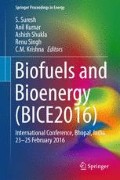Abstract
This study focuses on the review of vermicomposting of different leaf litters such as forest litters, polyalthia longifolia, mango, eucalyptus, neam, and water hyacinth with vegetable, agro-residues, kitchen and mixed liquor suspended solid wastes, institutional and industrial (sludge and fibres) waste and Rice husk. Leaf litter accumulating in the urban and suburban locations such as sidewalks and roadside which adds to the overall problem of municipal solid waste disposal. In India and other several countries, leaf litter is often piled-up and set on fire which adds to air pollution. Vermicomposting is the best known process for the biological stabilization of solid organic wastes. Vermicomposting involves the use of earthworms to mix, fragment and aerate organic waste material, making it more conducive to microbial activity and results highly humified product which contains most nutrients in plant-available forms such as nitrates, phosphates, and exchangeable calcium and soluble potassium and also reduction of pathogens.
Access this chapter
Tax calculation will be finalised at checkout
Purchases are for personal use only
References
Aira M, Monroy F, Domínguez J (2007) Eisenia fetida (Oligochaeta: Lumbricidae) modifies the structure and physiological capabilities of microbial communities improving carbon mineralization during vermicomposting of pig manure. Microb Biol 54:662–671
Domínguez J, Edwards CA (1997) Effects of stocking rate and moisture content on the growth and maturation of Eisenia andrei (Oligochaeta) in pig manure. Soil Biol Biochem 29:743–746
Edwards CA, Bohlen PJ (1996) Biology and ecology of earthworms, 3rd edn. Chapman & Hall, London
Edwards CA, Fletcher KE (1988) Interaction between earthworms and microorganisms in organic-matter breakdown. Agr Ecosyst Environ 24:235–247
Edwards CA, Lofty JR (1972) Biology of earthworms. Chapman and Hall, London
Edwards CA (1998) The use of earthworms in the breakdown and management of organic wastes. In: Edwards, C.A. (Ed.), Earthworm Ecology. CRC Press. The Netherlands. 327–354
Edwards CA (2007) Earthworm ecology, 2nd edn. CRC Press
Fernandez-Go´mez MJ, Romero E, Nogales R (2010) Feasibility of vermicomposting for vegetable greenhouse waste recycling. Bioresour Technol 101(24):9654–9660
Gajalakshmi S, Abbasi SA (2004) Neem leaves as a source of fertilizer-cumpesticide vermicompost. Bioresour Technol 92:291–296
Gajalakshmi S, Abbasi SA (2002) Effect of the application of water hyacinth compost/vermicompost on the growth and flowering of Crossandra undulaefolia, and on several vegetables. Bioresource Technol 85:197–199
Hobson AM, Frederickson F, Dise NB (2005) CH4 and N20 from mechanically turned windrow and vermicomposting systems following in vessel pretretment. Waste Mang 25(4):345–52.
Katiyar RB, Suresh S, Sharma AK (2013) Characterisation of Municipal solid waste generated by the City of Bhopal, India. Int J Chem Tech Res 5(2):623–628
Katiyar RB (2014) PhD thesis, titled “optimization of engineering and process parameters for vermicomposting”. Department of Chemical Engineering, MANIT Bhopal, India, Page No. 188+xx
Khwairakpam M, Bhargava R (2009) Vermitechnology for sewage sludge recycling. J Hazard Mater 161(2–3):948–954
Lee KE (1992) Some trends opportunities in earthworm research or: Darwin’s children. The future of our discipline. Soil Biol Biochem 24:1765–1771
Manna MC, Jha S, Ghosh PK, Acharya CL (2003) Comparative efficacy of three epigeic earthworms under different deciduous forest litters decomposition. Biores Technol 88:197–206
Nath G, Singh, Keshav, Singh DK (2009) Chemical Analysis of Vermicomposts / Vermiwash of Different Combinations of Animal, Agro and Kitchen Wastes. Aust J of Basic and Appl Sci 3(4):3671–3676
Ndegwa PM, Thompson SA (2000) Effects of C-to-N ratio on vermicomposting of biosolids. Bioresour Technol 75:7–12
Ndegwa PM, Thompson SA, Das KC (2000) Effects of stocking density and feeding rate on vermicomposting of biosoilds. Bioresour Technol 71:5–12
Neuhauser EF, Kaplan DL, Malecki MR, Hartenstein R (1980) Materials supporting weight gain by the earthworm Eisenia fetida in waste conversion systems. Agric Wastes 2:43–60
Reinecke AJ, Viljoen SA (1990) The influence of feeding patterns on growth and reproduction of the vermicomposting earthworm Eisenia fetida (Oligochaeta). Biol Fertil Soils 10:184–187
Reinecke AJ, Viljoen SA, Saayman RJ (1992) The suitability of Eudrilus eugeniae, Perionyx excavatus and Eisenia fetida (Oligochaeta) for vermicomposting in Southern Africa in terms of their temperature requirements. Soil Biol Biochem 24:1295–1307
Singh J, Kaur A, Vig AP, Rup PJ (2010) Role of Eisenia fetida in rapid recycling of nutrients from bio sludge of beverage industry. Ecotoxicol Environ Saf 73:430–435
Suthar S (2009) Vermistabilization of municipal sewage sludge amended with sugarcane trash using epigeic Eisenia fetida (Oligochaeta). J Hazard Mater 163:199–206
Wani K.A., Mamta and R.J. Rao (2013) Bioconversion of garden waste, kitchen waste and cow dung into value-added products using earthworm Eisenia fetida. Saudi J Biol Sci 20(2):149–154.
Zhenjun S (2004) Vermiculture and vermiprotein. China Agricultural University Press, Bejing
Author information
Authors and Affiliations
Corresponding author
Editor information
Editors and Affiliations
Rights and permissions
Copyright information
© 2017 Springer International Publishing AG
About this paper
Cite this paper
Katiyar, R.B., Suresh, S., Sharma, A.K. (2017). A Review on Vermicomposting of Different Leaf Litters. In: Suresh, S., Kumar, A., Shukla, A., Singh, R., Krishna, C. (eds) Biofuels and Bioenergy (BICE2016). Springer Proceedings in Energy. Springer, Cham. https://doi.org/10.1007/978-3-319-47257-7_28
Download citation
DOI: https://doi.org/10.1007/978-3-319-47257-7_28
Published:
Publisher Name: Springer, Cham
Print ISBN: 978-3-319-47255-3
Online ISBN: 978-3-319-47257-7
eBook Packages: EnergyEnergy (R0)

